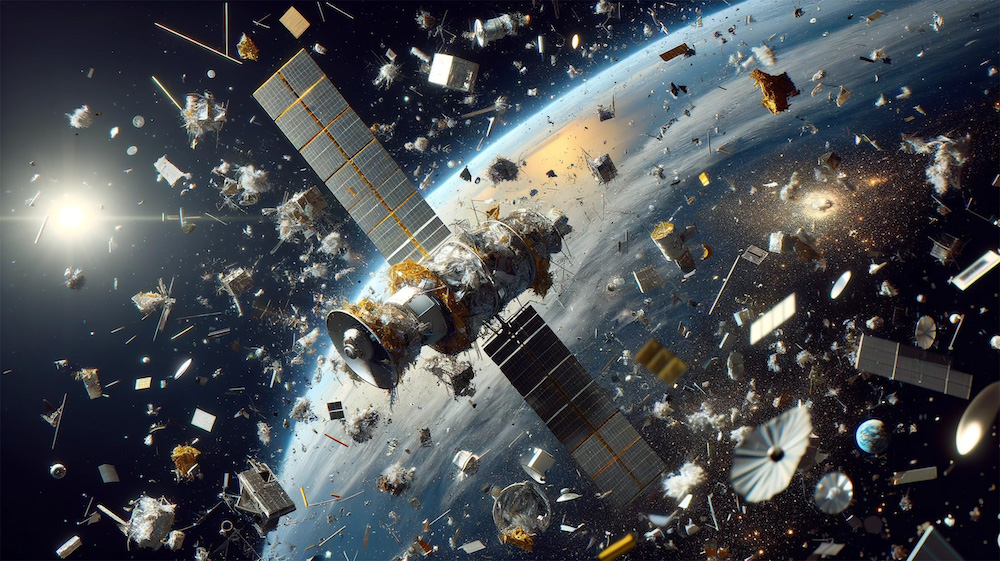
As we gaze upon the celestial tapestry of the night sky, a sense of awe washes over us. Yet, nestled amongst the twinkling stars and celestial ballet of planets lurks a hidden threat – a growing cloud of man-made debris orbiting Earth at breakneck speeds. This isn’t the stuff of science fiction, but a very real challenge demanding the immediate attention of the international community: space debris.
This ever-increasing accumulation of defunct satellites, spent rocket bodies, and countless microscopic fragments poses a significant threat to the future of space exploration and the delicate balance of our near-Earth environment. The situation is akin to a celestial junkyard, congested with remnants of humanity’s burgeoning spacefaring endeavors. Here’s why space debris is a growing concern:
-
The Kessler Syndrome: A Domino Effect in Space: Imagine a cosmic cascade of collisions. The chilling scenario known as Kessler Syndrome paints a grim picture. Collisions between debris objects create even more debris, exponentially increasing the risk of further collisions. This self-perpetuating cycle could render vital orbital paths unusable, hindering space exploration and jeopardizing operational spacecraft.
-
Crippling Operational Satellites: Our modern world relies heavily on constellations of satellites for crucial services like communication, navigation, and weather monitoring. Even a tiny shard of debris, hurtling at thousands of kilometers per hour, can inflict significant damage on these vital assets. A collision with debris could render them inoperable, disrupting these critical functions.
-
A Threat to Human Spaceflight: The International Space Station (ISS), a marvel of international collaboration, and future crewed missions face a constant threat from space debris. A collision with a large piece of debris could be catastrophic for astronauts onboard, highlighting the urgency of addressing this issue.
Identifying the Culprits Behind the Cosmic Clutter:
To effectively tackle this challenge, we must first understand the sources of space debris:
-
Defunct Satellites: These are satellites that have reached the end of their operational lifespan and continue to orbit Earth. With no way to de-orbit them, they contribute significantly to the debris cloud.
-
Rocket Bodies: The upper stages of rockets launched into space often don’t re-enter the atmosphere and remain in orbit, adding to the debris problem.
-
Fragmentation Events: Collisions between existing debris objects create even smaller fragments, further increasing the overall debris population. This self-perpetuating cycle underscores the need for immediate action.
Charting a Course for a Sustainable Space Environment:
The future of space exploration hinges on our ability to maintain a clean and sustainable space environment. Here are some potential solutions on the horizon:
-
Active Debris Removal (ADR): Envision a celestial sanitation crew! ADR technologies are being developed to capture and de-orbit defunct satellites or large debris objects. These technologies could involve robotic arms, harpoons, or even lasers to nudge debris out of operational orbits.
-
Passivation of Satellites: Responsible spacefaring practices are key. Implementing procedures to ensure satellites don’t explode or release debris at the end of their lifespan is crucial. This could involve depleting onboard fuel and batteries before de-orbiting, minimizing potential hazards.
-
The Art of Avoidance: Equipping spacecraft with advanced collision avoidance systems is another crucial step. These systems can detect and maneuver spacecraft away from potential collisions with debris, enhancing safety and mission success.
-
Designing for Demise: Imagine satellites that self-destruct responsibly! Satellites can be designed with features that facilitate their natural de-orbiting at the end of their lifespan. This could involve using materials that burn up more readily during atmospheric re-entry, reducing the long-term debris burden.
-
A Global Effort: Space debris is a global challenge, not a national one. International collaboration on debris mitigation strategies, technology development, and data sharing is essential for a sustainable solution. Spacefaring nations and private companies must work together to ensure the future of space exploration.
The Role of Private Companies and Space Agencies:
As the space industry witnesses a surge in private companies, fostering responsible practices is paramount:
-
Private Companies as Stewards of Space: Many private companies are now entering the space race. Implementing responsible practices, such as adhering to debris mitigation guidelines and designing for de-orbiting, is crucial for long-term sustainability.
-
Space Agencies: Leading the Way: Government space agencies have a critical role to play. They can provide leadership by funding research and development of debris removal technologies, establishing international cooperation frameworks, and advocating for responsible practices in the space industry.
A Collaborative Mission
The issue of space debris demands a collective effort. Continuous innovation in debris removal technologies, adherence to international regulations, and fostering international cooperation are essential steps towards a pristine and sustainable space environment.
Benefits of a Clean Space Canvas
Maintaining a clean space environment offers a plethora of benefits, not just for scientific exploration, but for humanity as a whole:
-
Safer Space Exploration: Reduced debris hazards will allow for safer and more reliable space exploration missions. This can open doors for further scientific discovery, potentially unlocking the secrets of the universe and paving the way for advancements in areas like asteroid mining and deep space exploration.
-
Protection of Our Technological Lifeline: Operational satellites crucial for communication, navigation, and weather monitoring will be less susceptible to damage from debris collisions. This ensures uninterrupted access to these critical services, fostering global connectivity and enabling accurate weather forecasting, which is vital for disaster preparedness and mitigation.
-
Economic Growth: A thriving space economy hinges on a safe and accessible space environment. Tackling space debris will foster long-term economic opportunities in the space sector, leading to advancements in satellite technology, space-based services, and potentially even space tourism.
-
A Sustainable Future for All: By addressing the issue of space debris, we are ensuring a sustainable future for space exploration and the benefits it yields. This commitment to responsible spacefaring practices demonstrates our ability to think long-term and safeguard this precious resource for generations to come.
A Call to Action: A Shared Responsibility
Space debris is not an insurmountable challenge. By embracing collaborative solutions, advocating for responsible practices, and investing in the future of space exploration, we can ensure that the night sky remains a canvas for discovery, wonder, and the boundless potential of humanity.
Here’s how you can contribute:
-
Advocate for Responsible Space Practices: Encourage governments and space agencies to adopt policies and regulations that promote responsible space practices, such as debris mitigation measures and end-of-life satellite disposal plans.
-
Support Research and Development: Research and development of debris removal technologies are crucial. Consider supporting organizations or initiatives focused on developing innovative solutions.
-
Spread Awareness: Educate others about the issue of space debris and the importance of a sustainable space environment. Sharing information and fostering a global conversation can drive positive change.
A Canvas for the Future
The vast expanse of space beckons us with its mysteries and potential. By addressing the issue of space debris today, we can ensure that this celestial canvas remains pristine, fostering scientific exploration, technological advancements, and the continued inspiration of humankind. Remember, the future of space exploration, and the continued benefits it offers to our planet, depends on our collective responsibility to maintain a sustainable space environment. We stand at a crossroads – a choice between a cluttered canvas and a clear one. Let’s choose wisely, for the sake of our future and the generations to come.
Global Business Opportunities in Space Debris and Maintaining a Sustainable Space Environment
The growing issue of space debris presents a significant challenge, but also opens doors for substantial business opportunities. The global market for space debris removal and sustainable space environment solutions is estimated to be in the billions, with significant potential for growth in the coming years. Here’s a breakdown of the market size and potential areas for business involvement:
Market Size:
- Estimated Value: The market for space debris removal and related technologies is projected to reach USD 12.8 billion by 2027, with a Compound Annual Growth Rate (CAGR) of over 15%.
- Market Segments: The market can be segmented into various areas, each presenting unique business opportunities:
- Debris Removal Technologies: This segment includes development, manufacturing, and deployment of technologies like robotic arms, harpoons, nets, or lasers for capturing and de-orbiting debris.
- Space Situational Awareness (SSA) Systems: This market encompasses technologies for tracking and monitoring space debris, providing crucial data for collision avoidance and debris removal missions. Companies specializing in sensor development, data analysis, and software solutions are well-positioned.
- End-of-Life (EOL) Satellite Management: Developing solutions for safely de-orbiting satellites at the end of their lifespan offers business opportunities. This could involve technologies for propulsion systems, on-board passivation measures, or controlled re-entry techniques.
- Materials Science: Advanced materials that facilitate natural de-orbiting of satellites by burning up more readily in the atmosphere present a lucrative market.
Growth Drivers:
- Increasing Space Traffic: The growing number of satellites being launched, particularly by private companies, contributes to the rising space debris population. This fuels the demand for debris mitigation and removal solutions.
- International Regulations: As the international community recognizes the threat of space debris, stricter regulations mandating debris mitigation by spacefaring nations and private companies will drive innovation and market growth.
- Advancements in Technology: Continuous advancements in robotics, artificial intelligence, and space propulsion technologies will enable the development of more efficient and cost-effective debris removal solutions.
- Economic Benefits of a Clean Space Environment: A clean space environment fosters a thriving space economy, leading to increased investment in debris mitigation and related technologies.
Regional Variations:
- North America and Europe: These regions are expected to remain the dominant markets due to the presence of established space agencies and leading companies in debris removal technologies.
- Asia Pacific: This region is experiencing rapid growth in its space sector, with an increasing focus on debris mitigation. This presents significant business opportunities for companies offering relevant technologies and services.
Areas for Business Opportunities:
- Developing and Deploying Debris Removal Systems: Companies specializing in robotics, engineering, and space propulsion systems can contribute significantly by developing and deploying debris removal technologies.
- Advanced Space Situational Awareness (SSA) Solutions: Companies offering advanced sensors, data analytics, and software platforms for tracking and monitoring space debris will play a crucial role.
- EOL Satellite Management Services: Companies can offer services for responsible end-of-life management of satellites, including on-board passivation measures and controlled de-orbiting solutions.
- Advanced Materials Development: Material science companies can develop advanced materials for satellites that facilitate natural de-orbiting at the end of their lifespan.
- Data Analytics and Risk Assessment: Companies specializing in space data analysis and risk assessment can offer valuable insights for collision avoidance and debris removal mission planning.
- Insurance and Risk Mitigation Services: As space activities increase, insurance companies can develop specialized policies to mitigate risks associated with space debris collisions.
Challenges and Considerations:
- High Development Costs: Developing and deploying debris removal technologies can be extremely expensive. Companies need to secure funding and establish strategic partnerships to advance these technologies.
- Technological Challenges: Debris removal presents significant technical hurdles. Companies need to address challenges related to capturing and maneuvering large or high-speed debris objects in the harsh space environment.
- International Cooperation: Effective solutions require global collaboration. Companies need to navigate complex international regulations and establish partnerships across borders.
The issue of space debris presents a significant global challenge, but also opens doors for substantial business opportunities. By developing innovative technologies and services, companies can play a vital role in ensuring a sustainable space environment for future generations. Collaboration between private companies, space agencies, and research institutions is key to unlocking the full potential of this emerging market. As the space economy continues to grow, responsible space practices and debris mitigation solutions will become essential for long-term success.






